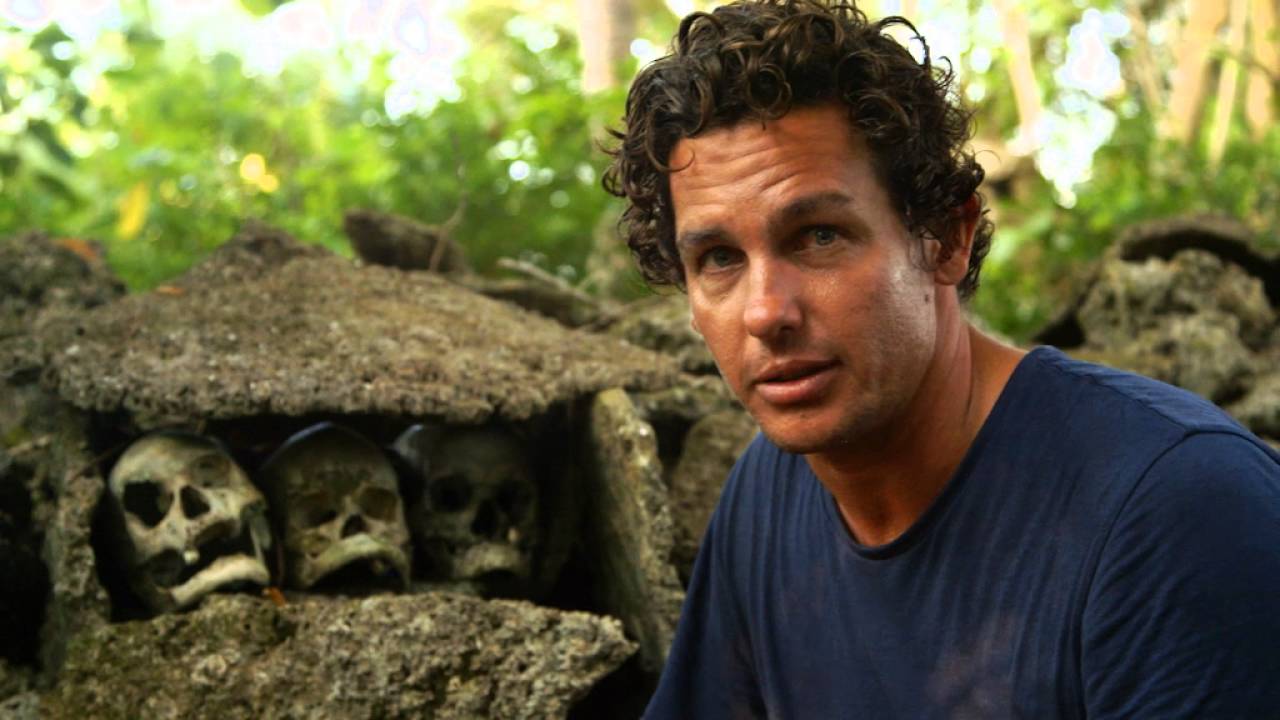I am not much of a history buff, World War II or otherwise. My vision of the Solomon Islands during the war leans more toward the fiction of James Michener’s Tales of the South Pacific — a dreamy embarrassment of verdant tropical growth, empty beaches, crystalline seas with abundant marine life and friendly locals with endless smiles. With each return visit, I scratch more notes on my deeply creased Solomon Islands map while island-hopping to a few of the nine provinces.
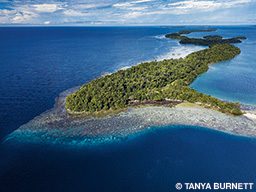
After landing in Honiara, the capital city seems as chaotic as ever. Locals are heading to the markets for fruit, vegetables, fish and betel nut. Trucks full of fresh-cut timber rumble by, and hundreds of flip-flopped feet move to the rhythm of daily life. Almost everything that enters or leaves the Solomon Islands does so in Honiara. My dives start here on the famous submerged war monuments that draw history enthusiasts and divers from every corner of the globe.
Guadalcanal Province
As our pickup truck bounces down the coastal road, my dive guide explains the nickname Iron Bottom Sound for the waters off Guadalcanal, earned from the abundance of American and Japanese World War II wreckage there. A quick glimpse of calm seas between impossibly tall coconut palms confirms we can dive the Bonegi wrecks: the Japanese military transport Hirokawa Maru (Bonegi 1) and freighter Kinugawa Maru (Bonegi 2), both of which sank in 1942.

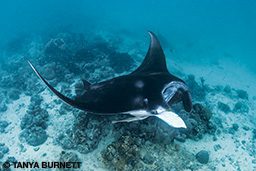
The Hirokawa Maru lies on its port side with the remains of the bow at about 15 feet and the stern at deeper than 180 feet. The captains of many of these ships ran them ashore to prevent them from sinking in deep water. This life-saving effort has created remarkable shore dives in the area, some of which still break the surface near the beach.
A few fin kicks from shore we maneuver our way along the crumbling remains of the deck, which is now draped in a vibrant patchwork of corals. Big schools of chubs circle the structure, while delicate damsels, butterflyfish and anthias dart furtively at our approach. Dozens of species of hard corals compete for upper surfaces dappled by sunlight, while soft corals cascade like tie-dyed scarves from the lower surfaces. As with many of the wrecks on the shoreline slope, we could go deep toward the stern, but I am content with the infectious buzz of activity above 70 feet.
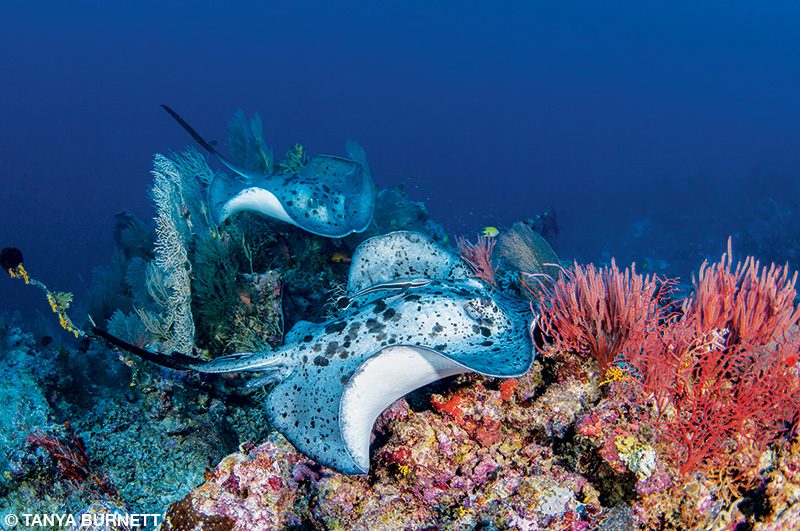
The Kinugawa Maru rests even shallower and closer to the beach. This enormous artificial reef is awash in the midday sun and plays host to even more life than the Hirokawa. Eighty years of wear have reshaped the architecture of the shallow remains into an interesting habitat. Giant anemones give sanctuary to several species of anemonefish that are busy parenting clutches of eggs. Large gorgonian sea fans sway with the gentle surge. Sand dwellers and rays hug the bottom along the wreck, and larger fish seek safety in holes within the jagged infrastructure. Houndfish hunt along the surface, and camouflaged predators such as scorpionfish hide in plain sight. Barracudas and lionfish hover motionless while keeping a watchful eye on glistening bait fish.
More wreck sites are reachable westward along the north coast, so we end our day with a J1 Japanese submarine and the remains of an American B-17 Flying Fortress. The fuselage and wings are clear and the guns still visible, but most amazing are the intact cockpit controls.
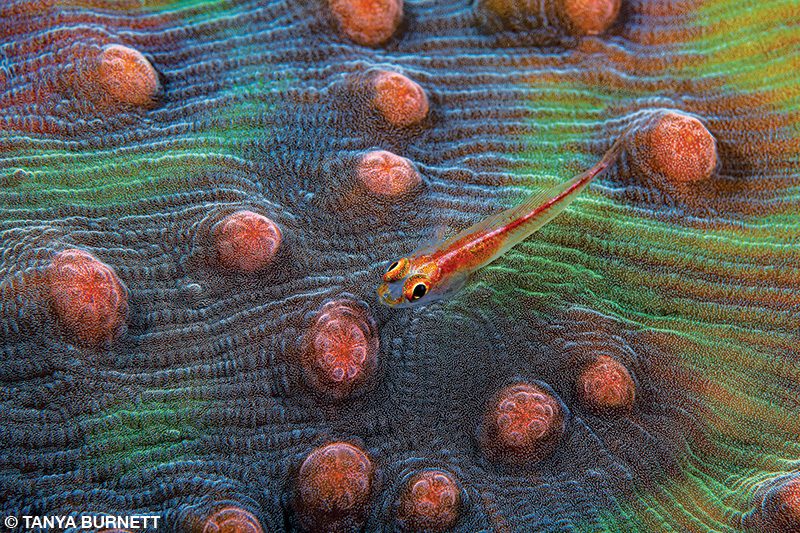
Central Province
Heading across Iron Bottom Sound brings us to Tulagi in the Florida Islands. It was a primary base for the Japanese during the war because of its deep harbor. Dives here include destroyers, oilers, a minesweeper, wildcats and equally abundant natural reefs that include walls, pinnacles and even muck sites. With limited time here, I asked my guide what he would dive. He grinned and told me to follow him.
Only a few miles from the main harbor is a Japanese Kawanishi H6K “Mavis” seaplane at 100 feet, just offshore from the historic Ghavutu Island. The plane is almost fully intact, with huge sponge growth festooning the stilled propellers. The nutrients reduce visibility but have led to an explosion of life on every inch of the plane. Forests of black coral sway delicately on the wings with an ethereal fog of glassfish mingling in the delicate, feathery branches. Groupers and frogfish stealthily wait to inhale a careless and unsuspecting meal. Bottom time goes quickly on the seaplane, but a beautiful reef in shallower water lets us extend our profile.
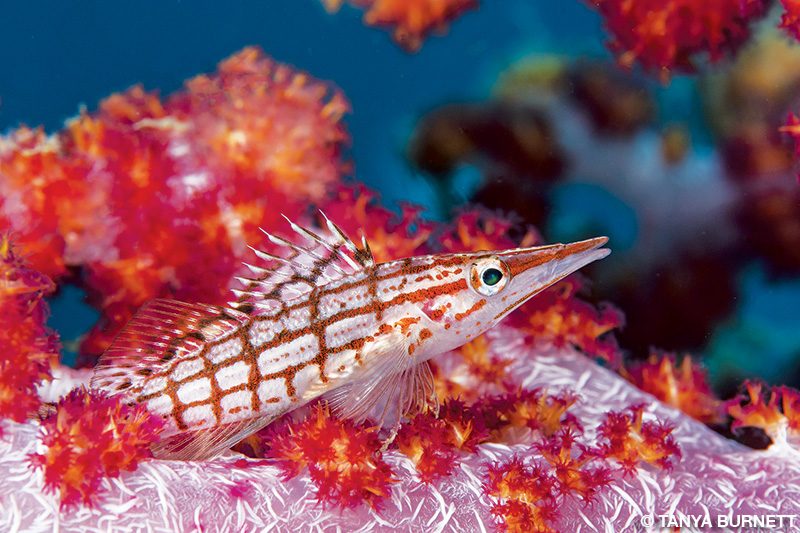
Our next dive is all nature as we drop in on Twin Tunnels, where two extinct lava tubes drop down from the top of a pinnacle and pop out at about 100 feet. Big schools of fusiliers, jacks, rainbow runners and ever-cautious reef sharks patrolling in the background greet us. We work our way back up the outside of the pinnacle along delicate gardens of staghorn and lettuce corals toward a crown of countless schools of chromis, small parrotfish and ruby-red pinjalo snappers.
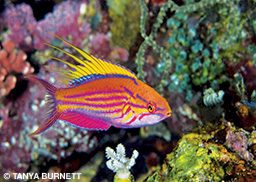
We zigzag between the beautiful Tavanuula Drift, highlighted by enormous purple and yellow elephant ear sponges, a wild reef manta dive at Devil’s Highway and exceptional macro muck diving at Maravagi Bay.
This trip offered some discoveries in the Florida Islands. A little white sand spit called Mbike in the Sandfly Channel is unassuming on the surface, but our dive reveals a healthy coral garden and massive Tridacna clams. Later we find a trawler wreck spectacularly draped in colorful soft corals and clusters of blue tunicates being ravaged in slow motion by the neon-bright Nembrotha nudibranchs.
A short boat ride away, the shallow reef of Simon’s Nature Reserve provides snorkeling in the shallows of a uniquely vibrant hard coral reef. Huge branching corals in royal purple, pink, mosslike green and powder blue reach for the unfiltered tropical sun. The quality and colors are beyond anything I have seen in decades of diving. My snorkel-vented exclamations of delight prompt a visit from Simon in his dugout canoe. Sporting a broad smile and speaking with obvious pride, this local villager explained his efforts to protect his special reef. Over time Simon has collected extensive varieties of corals from other island reefs and neighboring regions to build his own marine protected area, which is highlighted by markers to keep fishers and boaters from entering the zone. For a small fee he graciously allows divers and snorkelers to enjoy the fruits of his efforts.
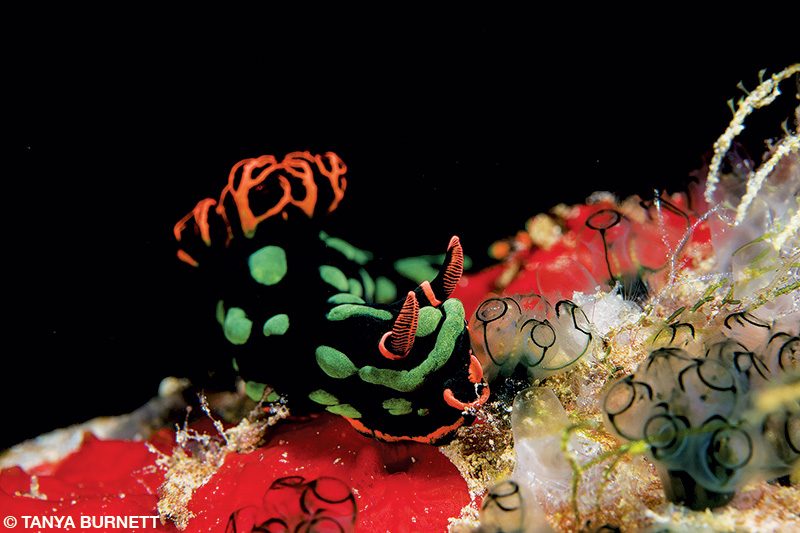
Russell Islands
A scattering of volcanic islands about 30 miles west of Guadalcanal is known to locals as the Russells. It is a spectacular dive region with deep caves, cuts, dropoffs and seamounts as well as some unusual World War II sites in the protected regions of the atoll.
Navigating the labyrinth of channels, bays and reefs on a liveaboard while enjoying the spectacular scenery between dives is the best way to experience some of the Solomon Islands’ most famous dive sites. High on my list from past visits is Leru Cut, where we navigate through a long vertical crack in the island to an opening surrounded by impressive jungle scenery. The trip back out to the open sea with the sun overhead provides the real magic as laserlike shafts of shimmering light pierce through rock openings and dance on the white sand bottom, rock walls and occasionally a diver. The exit is an intoxicating hue of ocean framed in a stark silhouette that sets a photographer’s heart fluttering.
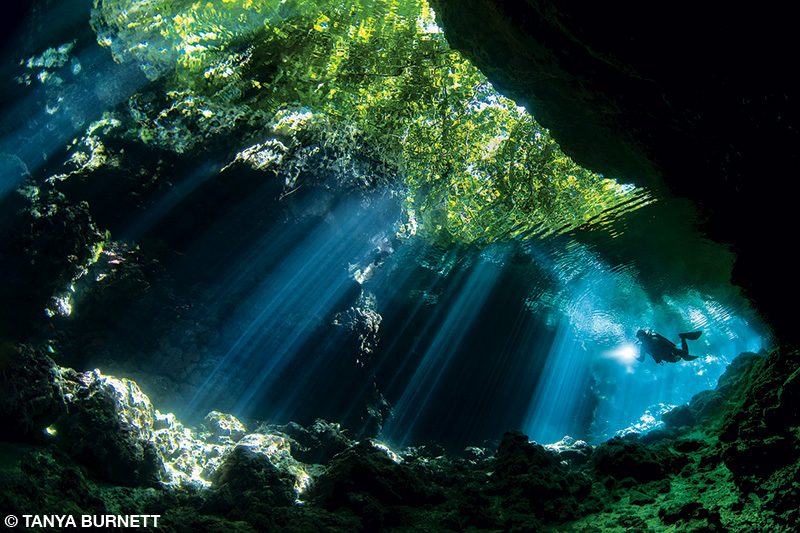
The Russells are home to many dives with incredible architecture and topography. Mirror Pond, Bat Cave and Custom Cave have short swim-throughs and cavelike openings in the reef that lead to island interiors of saltwater ponds full of trees, reefs and light. Small saltwater crocodiles occasionally rest in the crevices and ponds near the surface. The elegant outside reefs are home to one of my favorite Solomon macro subjects: tiny, colorful coral hermit crabs, which are gracious and willing subjects.
Mane Island is notable for its current-swept points full of unexpected action. Karumolun Point has a submerged promontory where big schools of jacks, barracudas, yellowfin tuna and juvenile gray reef sharks shift positions in the steady flow of water. The deeper plateau of the point is festooned with soft corals in brilliant colors of pink, yellow and scarlet made more dramatic by spotted eagle rays passing by in the blue.
White Beach has no beach, but this mangrove-lined shore next to a small village gives little hint to the underwater landscape. This former American military base had cargo docks during the war, but their orders were to dump everything from the base into the sea when the Americans left. No current disrupts the time capsule beneath the surface, which includes vehicles, tires, weapons, dock structures and more, all wearing sponges and soft corals like gaudy feather boas. The highlight of the steep slope is the macro and small fish behavior. On this visit, schools of archerfish hover in the mangrove roots, while nudibranchs, shrimp and eels gather in the shallow dock framework.
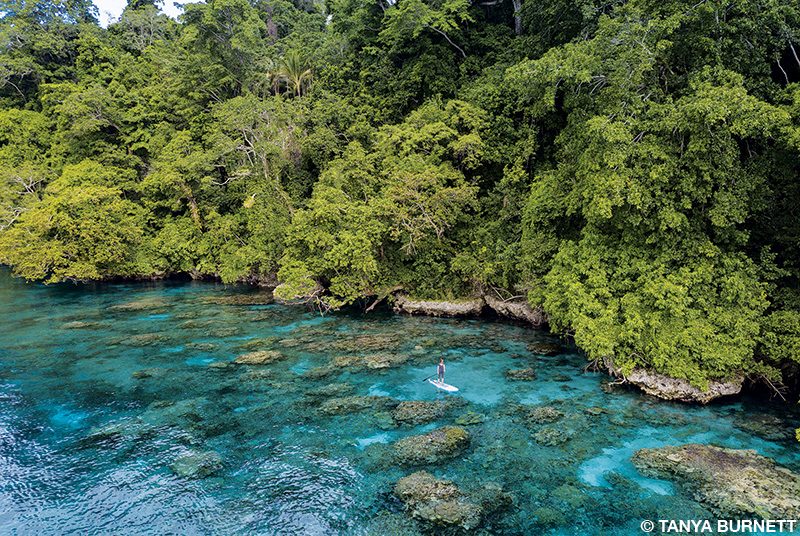
Western Province
The largest of the Solomon Islands’ nine provinces, Western Province is renowned for its beautiful tropical islands, stunning coral reefs and more World War II wrecks. On the liveaboard route to this region from the Russells is an uninhabited chunk of rock and trees called Mary Island, which is renowned for pelagics and loads of fish life. After shooting circling jacks here until I was dizzy, I switched lenses and missions.
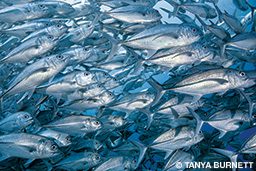
Mary Island is one of the most reliable locations to photograph the elusive and frustratingly shy flame angelfish and the equally challenging red-spotted blenny. The flame angels reside in the 40-foot range, often in the channels where the current pours through. Patience is the name of the game on my dive until I suddenly catch a glimpse of signature burnt tangerine. These fish don’t swim far, so it is a satisfying stalk-and-wait operation when I finally score a few shots of this beauty.
I spend the rest of my dive sloshing around in the surge on bare rock in 7 feet of water, lining up a 105mm macro lens with a 4X macro converter just to capture the cutest face in the ocean: the red-spotted blenny. This irresistible clownlike character is incredibly difficult to shoot. When not cursing through my regulator, I am laughing hard enough to lose it — and so it is with most underwater photography.
Morovo Lagoon
When viewed from the air the Morovo region is like a picture-perfect postcard, featuring 1,000 square miles of a double barrier reef with three large volcanic islands and a lagoon bejeweled with hundreds of other small, forested islands. On the west side of the lagoon near the little village of Seghe is a small landing strip and a wooden shack that serves as the airport terminal. From this former World War II base divers could spend weeks circumnavigating through the lagoon’s countless historical and natural dive sites and possibly even discovering new ones. There are coral reef passes full of fish at Charapoana and relaxing glides over incredibly pristine hard coral gardens at Sambulo Island. A bevy of manta rays at a cleaning station in 20 feet of water greets us on an early morning dive, while other divers go for a mazelike adventure at the edge of the deep New Georgia Sound.
On the southwest side we discover something special. The visibility at Kicha Island, on the outer edge of the lagoon, borders on forever. Massive red gorgonian sea fans adorn the steep walls and attract cascades of batfish, black snappers, circling barracudas and the occasional rainbow runner. Following a rain of coral powder drifting in front of my mask, I go shallower on the wall to find large schools of bumphead parrotfish grazing on coral and carousing on the reef like herds of underwater buffalo. If all this commotion is not enough, regular chest-thumping explosions from the active submarine volcano Kavachi punctuate our dive as it erupts a mere 25 miles away. Disconcerted at first, I eventually grow enamored of the extra excitement.
Roviana Lagoon
The ancient history of the Roviana region includes time as a trading hub for shell currencies and a reputation for headhunting, but the past has disappeared into the shifting mosaic of blue shades artistically ringed by barrier reefs and islets. While the friendly locals are happy to share artifacts of their past, they peacefully embrace the present. The rustic outpost of Munda, the largest settlement on the island of New Georgia, functions as the jumping-off point to many historical World War II sites above and below the water.
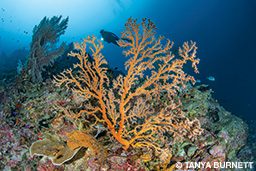
We take a boat ride out and drop into a calm swell against high limestone cliffs at a site called Mbigo Mbigo and are immediately floating among fields of hard corals. The reef rolls down into the blue and, as is the case in much of the Solomons, the pelagics are here in force. Dogtooth tunas, barracudas and a loose school of mackerels pass with a wary eye toward the bubble blowers. Every inch of the reef is alive with swarms of hundreds of black durgons.
The next dive at Tombatuni offers similar pleasures and incredible water clarity on the outside reef. Hawksbill turtles busily munch on soft coral, a school of batfish hovers in the protection of a sunken log, and a couple of blacktip reef sharks patrol in the distance. Upon reaching the point we see a tornado of schooling jacks and the elegance of effortlessly gliding eagle rays. We didn’t have the opportunity to dive Shark Point, Aussie Point and Top Shelf on this trip, but our guide told us that they are equally impressive sites.
My dive into history continues with a Japanese freighter sunk in Mbaeroko Bay and an abundance of plane wrecks: a Grumman F4F Wildcat fighter, a Vaught F4U Corsair, a Bell P-39 Airacobra and a Douglas A-24 Banshee dive bomber.
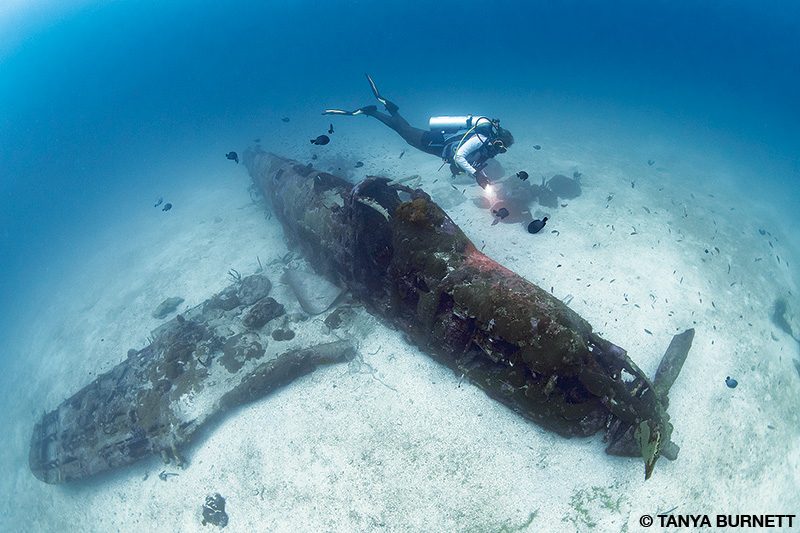
I may not understand all the details of every wreck I saw during this trip, but I feel a greater respect for the enormity of what occurred on this small tropical foothold during World War II. I also now appreciate more than ever what nature can do to reclaim the scars of human conflict. When the last bit of historical steel rusts away, the reef that consumes it will still be here to greet visitors and divers in the Solomon Islands.
How To Dive It
Getting there: The most direct route from the U.S. to the main hub of Honiara (HIR), Guadalcanal, is via Nadi, Fiji Islands, on Fiji Airways. Other routes go through Australia and connect to Brisbane for a Solomon Airlines flight to Honiara. Solomon Airlines recently started offering direct flights from Brisbane to Munda (MUA), New Georgia. Flights in and out of Honiara or Munda are not offered daily with all airlines, so plan to coordinate the best route for your time of travel. For information about visas and visitor permits, visit solomonislandsembassy.com/consular-services.
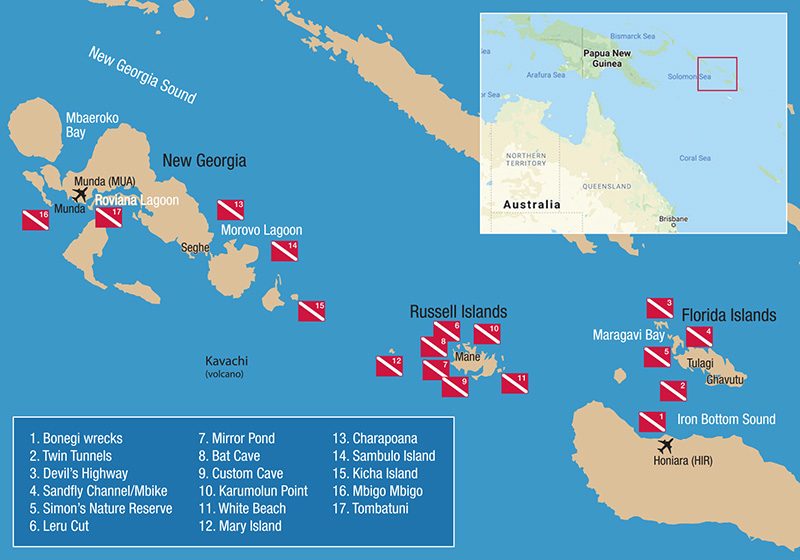
Conditions: The Solomon Islands are hot and humid all year round, with an average temperature of 80°F. There are two distinct seasons: a wet season from November to April and a dry season from May to October. Water temperatures range from 82°F to 84°F, so most divers are comfortable in a 2 mm or 3 mm full-length wetsuit. A hooded vest might be nice for a day with multiple dives. Water visibility differs greatly depending on location: The outer reef can be more than 100 feet, the inner reefs about 60 feet and the shallow lagoon areas with silty bottoms can be as low as 30 feet.
Topside: Try learning a few words in Pijin, the lingua franca, or ask about the native system of shell money, a form of traditional currency fashioned out of tiny seashells assembled into strings, necklaces and even headdresses. Visiting a village helps to support the community so they can continue to protect their reefs, and they are wonderful windows into the traditional Melanesian culture and daily lives. You may see a war canoe with a Nguzunguzu carving at the prow, which symbolizes a war god that watches out for enemies, reefs and sand bars, calms the seas and keeps away evil water spirits. In Munda you can see various collections of World War II hand grenades, machetes, dog tags, knives, coins, vintage Coke bottles, ammunition and countless other relics in home museums. To the west of Munda is Skull Island, where locals built a shrine to honor their past. The skulls of former Roviana chiefs adorn the shrine along with shell money and other offerings for good fortune.
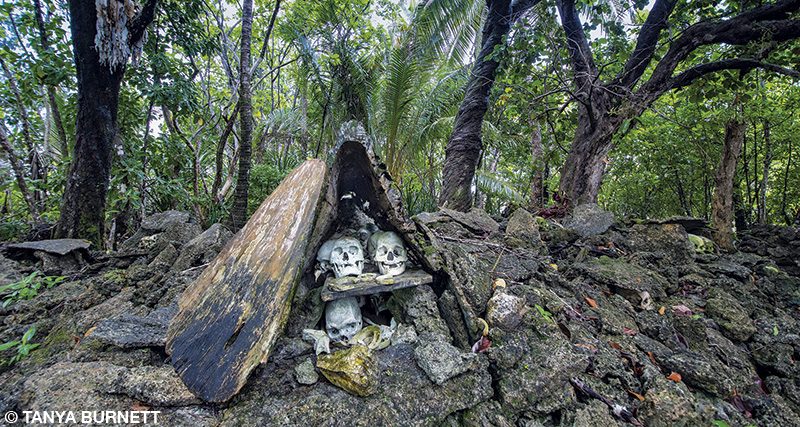
Explore More
Virtually visit the Solomon Islands in these videos, and then view Tanya Burnett’s bonus photo gallery.
© Alert Diver — Q3/Q4 2020
